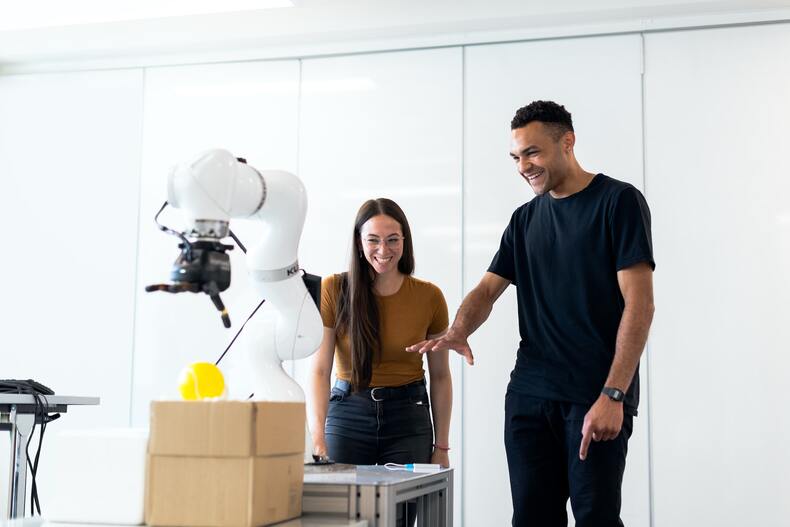The Robotics of the Future: How Does AI Apply to Robots?
Artificial intelligence includes various things, for instance, human-robot association, coordinated effort potential open doors, and quality. The development of AI has made it easier for robots to imitate human behavior, which is why they were made in the first place.
Robots that behave and think more like people may be able to fit into the workforce more easily and perform at a rate that is unmatched by human workers.
Trends in 2023: Robots that work together
The shift is evident in factories: The demand for autonomous mobile robotics that shares space with operators in warehouses has increased exponentially.
Utilization ease
This is good news for users. Another clear trend for 2022 is to simplify the implementation of industrial robotics, although Robotnik has always prioritized this aspect. The goal of software and hardware architecture is to make the interface, installation, and configuration easy and intuitive.
The development of more intelligent robots that can carry out more precise tasks is made possible by the maturation of several technologies, including artificial intelligence, 5G, and the Internet of Things.
Interoperability
Safety and productivity are improved when multiple robots, or fleets of robots, communicate with one another and other external systems.
Robotic systems are rapidly adapting new industries to automation. What will robots do from here on out? They will fundamentally adapt to user requirements. Companies are looking at new ways to respond to the new consumer behavior that has emerged following the pandemic.
Machine Vision
Robots are able to recognize and identify objects that they come into contact with, identify specifics, and learn how to navigate or avoid particular objects. Humans no longer need to direct robots along paths or process flows. Robots are now able to self-navigate and analyze their surroundings thanks to AI.
This capability is even applicable to software’s virtual world.AI aids robot software processes in avoiding process exceptions or flow bottlenecks. Robots can gain a better understanding of their surroundings, recognize patterns, and comprehend data with the assistance of artificial intelligence and machine learning (ML).
The robot’s autonomy is increased and its reliance on humans is reduced as a result of these enhancements.
What we get out of robots, like a lot of technological tools, will depend on how we use them.
Pros:
- Routine and time-consuming tasks can be offloaded and automated by humans.
- We can accomplish goals by utilizing the strength, tenacity, and tirelessness of a machine.
- Humans can benefit from robots’ increased mobility, reach, speed, productivity, and performance.
- They might be able to offer some users companionship and helpful communication.
- Robots perform tasks with greater precision and predictability.
Cons:
- Robots are capable of error. As with any piece of electronic equipment, they may be susceptible to technical failure, equipment glitches, software vulnerabilities, and high-tech glitches.
- They don’t always have the same thinking, speaking, or creative abilities as humans.
- The nitty-gritty nuances of human conversation and interaction, as well as the repercussions of their actions, are not always as quickly or precisely understood by robots.
- The cost of many robotic devices has not yet come down, preventing widespread consumer adoption.
- They require regular repair, retooling, upgrades, and maintenance.
Experts anticipate that robot technology will advance rapidly. The ability of robots to utilize solutions for natural language processing will advance, enabling them to process and interpret conversations with greater accuracy.
Experts anticipate that a greater number of self-aware and self-learning devices will enter the market, leading to significant advancements in AI and machine learning. Do you want to earn with the right kind of training? Become a part of stellar profit today.
PC vision, which engages innovative gadgets to detect, and perceive process still and video pictures as the natural eye would, ought to likewise work on automated execution. Droids of all kinds are also gradually getting better self-navigation capabilities, which make it easier for them to move around without the assistance of humans.
In point of fact, numerous businesses now offer the capability of instructing robots through digital simulations. To put it another way, the robots of tomorrow won’t just think, act, and respond in a more natural way. They will also benefit from improved fine motor skills and quicker response times.
Future Till 2050
By 2050, it will be second nature to interact with robots of all kinds, and we will increasingly encounter them everywhere. They’ll play bartenders, valets, chauffeurs, and a plethora of other roles. That is before you consider their increasing presence in the workplace, where helpful droids increasingly staff shipping centers and warehouses.
According to Ford, the workplace of the future will rely heavily on AI and machine learning-powered devices like robots. Their significance to organizations of all kinds will only increase in the future, he asserts.
Ford suggests that businesses that delay embracing these new technologies and making the most of them will almost certainly fall behind their competitors and lose their relevance in the coming years.

